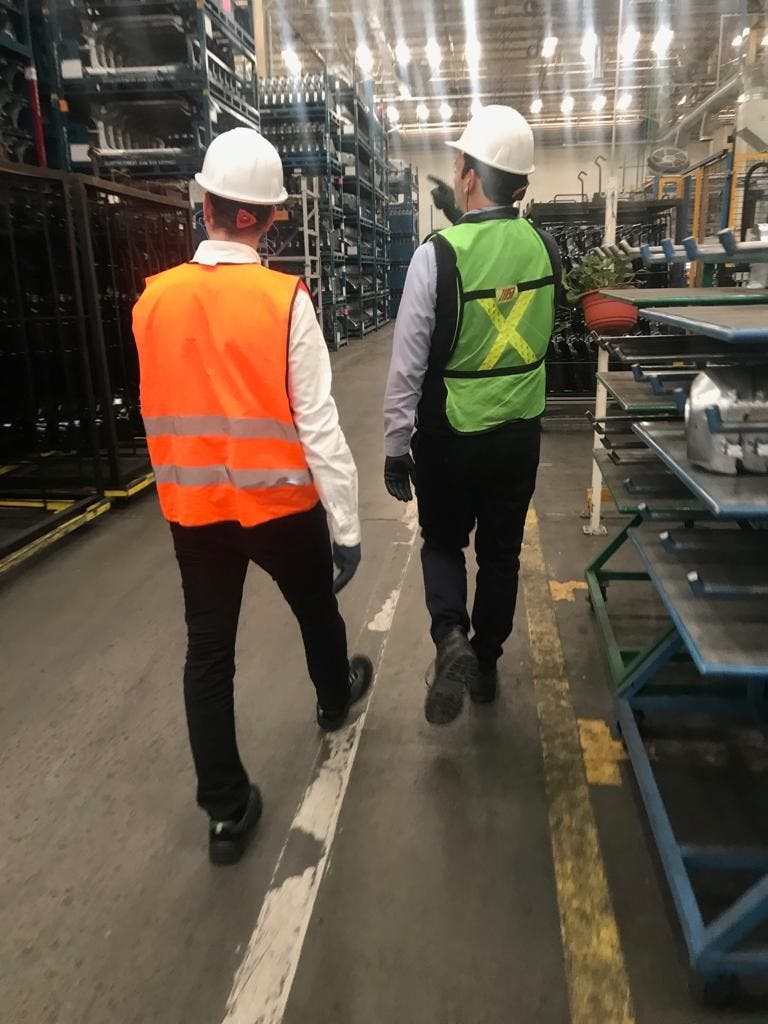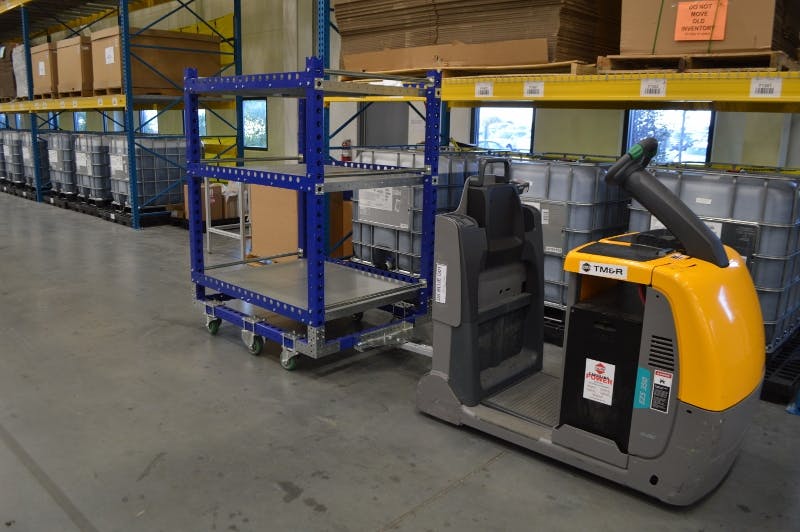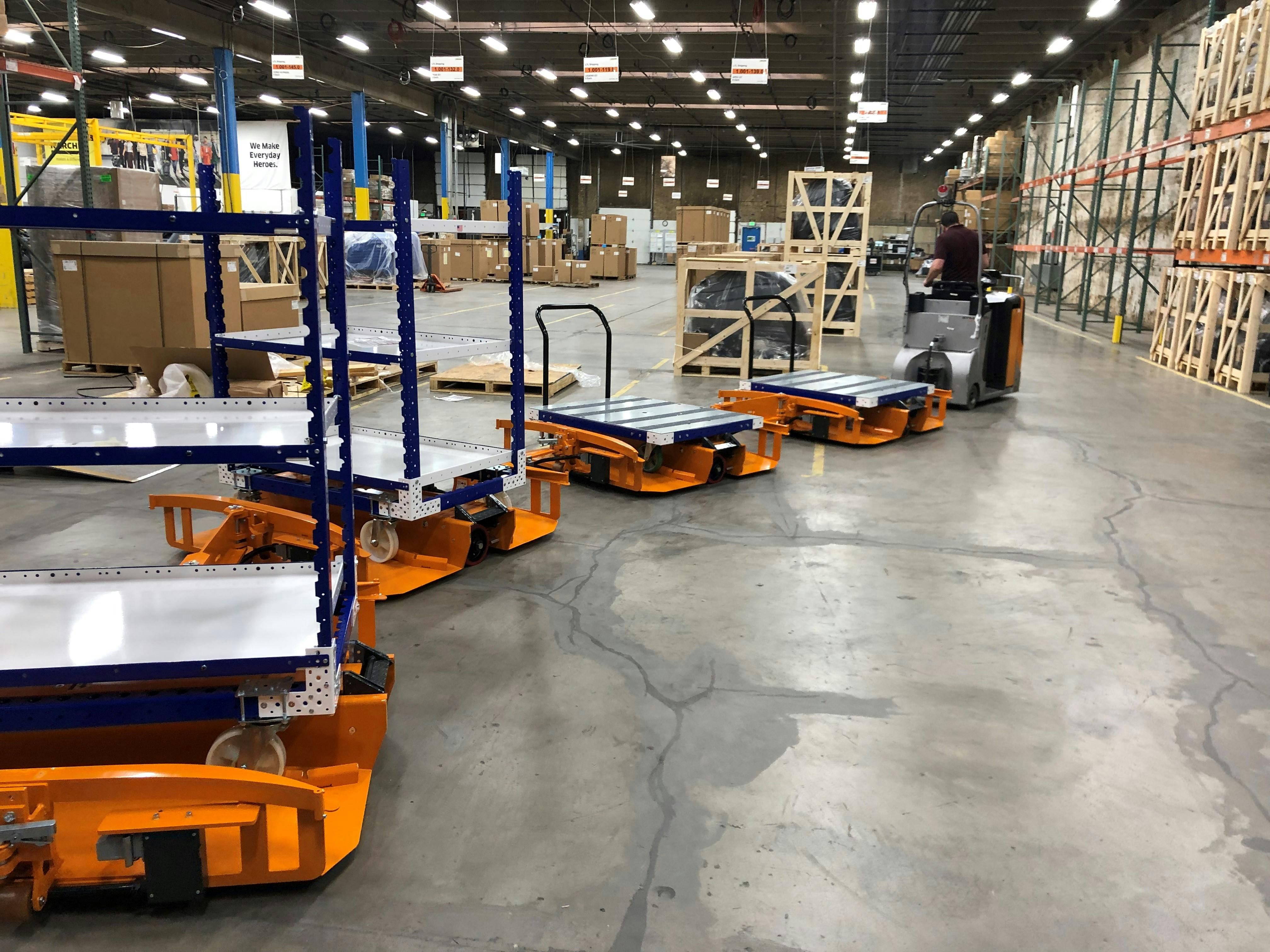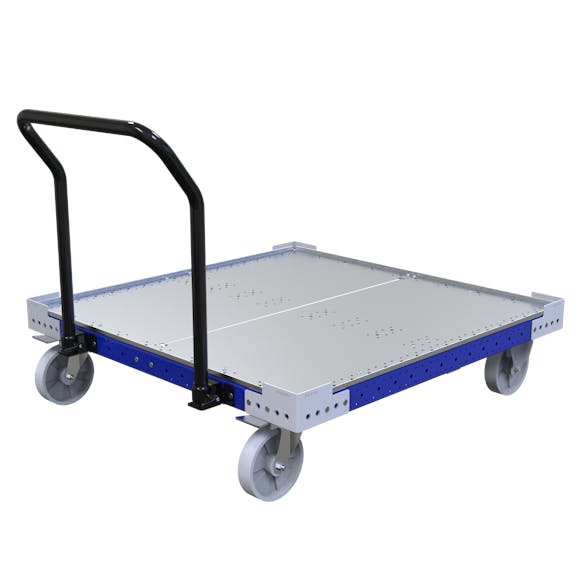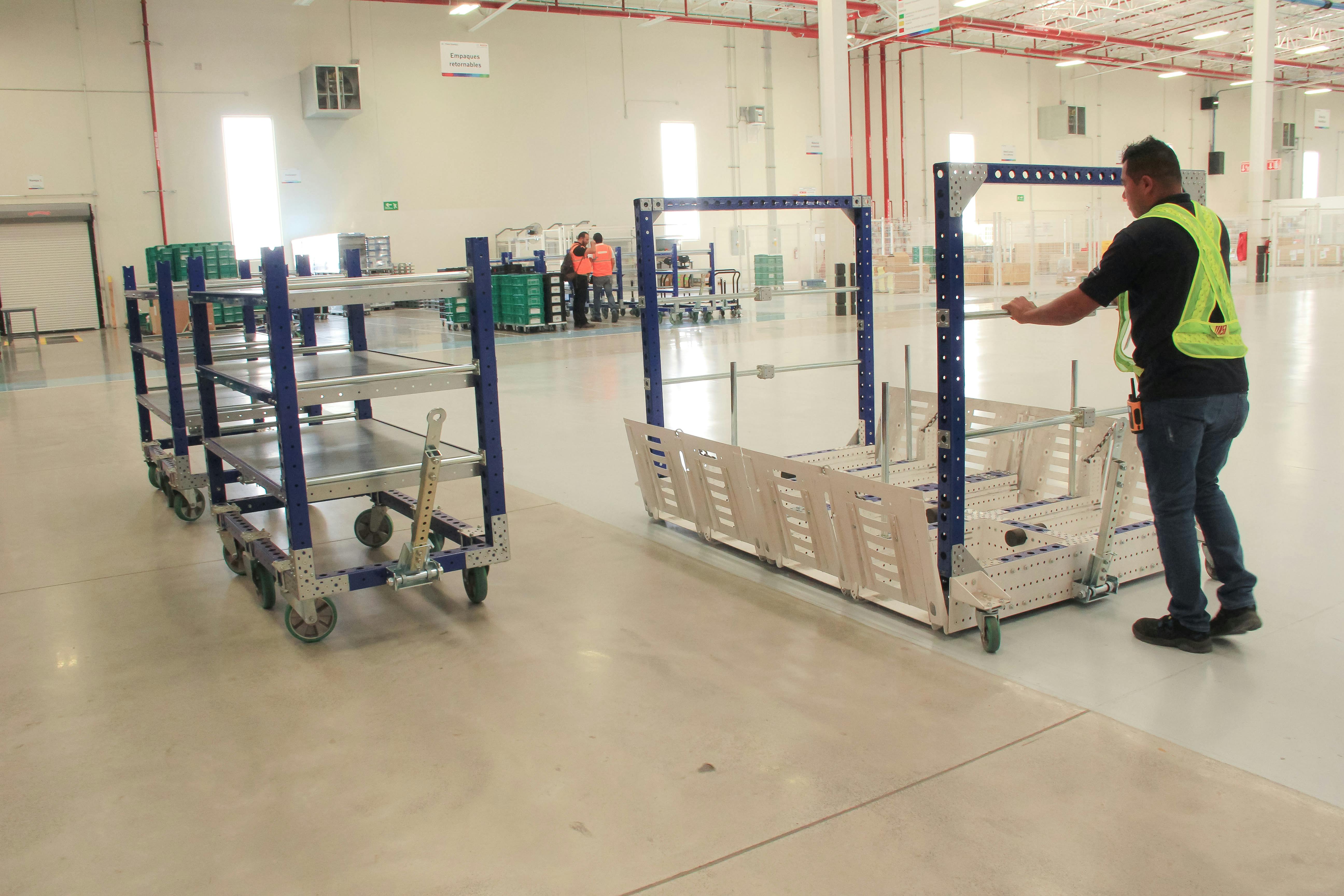Why do I need to put on all this safety gear if the plant is committed to safety?

Have you ever been to a manufacturing plant? The first thing you usually need to do after signing in as a visitor at the reception is to watch a video showing information about the plant you are about to enter. Since I have been to many manufacturing plants over the past decade, actually as many as 15 in a single week sometimes, I estimate the total number of plants I have entered adds up to more than 1000 over the past 10 years. Needless to say, I have watched a few of these safety videos.
One thing that never fails in being included in this is the information about the fork-lifts.
‘Watch out for the fork-lifts’,
‘Make sure to have eye-contact with the driver before crossing an aisle way’,
‘Remember: If you can’t see the driver, the driver can’t see you’.
And it’s not so strange that this piece of equipment is so frequently highlighted in these safety videos as it causes almost 100 deaths in the USA alone each year.
It also causes more than 35 000 accidents involving personal injury each year.
Nevertheless, the vast majority of plants I visit even in 2019 use forklifts as the main piece of equipment for transporting goods and material within the manufacturing operations.
And I am not talking about the warehouse, inbound or outbound docks. I still see a tremendous amount of forklifts honking their horn, stopping at crossroads to let people cross from one side to the other as they make their way out to the shop floor or driving back and forth, rather often with just two empty forks, with what seems like, an unsettled mission. Quite often I also see forklifts standing behind each other in a tight aisleway waiting for the one upfront to finish its work with loading or unloading a single piece of the load.
Forklifts are a great piece of equipment for many operations, not to say the least in docking operations, loading and unloading trucks or in put away process in warehouses. The name speaks for itself; fork-LIFT (are made for lifting).
For the majority of all manufacturing operations, the use of forklifts to move material from a warehouse or kitting operation to the assembly or production line are only the proof for very wasteful operations, opposite of lean manufacturing. The forklift survives the year 2019 in the kind of companies where planning and production are so poorly executed that the forklift is needed due to “flexibility” reasons. If the plant was operating at a pace that was known throughout the processes including the supply chain as well as running in a quality (e.g. Six Sigma stable process) the need for forklifts could be eliminated.
I believe that the hurdle to overcome the challenges with implementing fork-free manufacturing operations can be narrowed down to three main things:
- A Strong leadership with a future-oriented corporate culture
- A lean manufacturing philosophy
- A business case that covers all possible positive effects of reducing the number of forklifts
The Leadership.
Unfortunately, the lack of a clear vision and futuristic mindset is often a major obstacle for many forklift-free projects. Many leaders see new methods and ways of working as a potential risk and not as an opportunity. Clearly, every project that contains major opportunities to improve also comes with some risk. Otherwise, it would be way too easy. The road to perfection could be bumpy, but as the FlexQube mantra; Change is the Only Constant, we all know that Status Quo is not an option. The responsibility for the long-term development of a company always falls back on the management. Unless the people at this level are willing to take on some risk and potentially failing who else in the organization would?
A Lean Manufacturing Philosophy.
The human brain is very easy to fool. Something that moves quicker will always be thought of as more efficient compared to something that runs slower. A fast-moving, but empty forklift will easily be considered as more productive compared to a very slow running but fully automated tugger train with no driver pulling six carts. Most of the people involved in managing operations are very well aware of the different wastes that Lean Manufacturing is targeting. Even so, very few useful facts and figures to drive improvement activities. As many companies were focusing on eliminating waste in terms of inventory to free up cash flow, overproduction or over-processing, fewer are focusing on the waiting, movement (of people) or transport (of products/material). To be rather frank I would like to say that there are too many people with a business degree rather than engineering on management levels.
Business educated people tend to focus on the waste that mostly has an impact on cash flow and working capital. A swelling warehouse or additional processing (as well as extensive non-conformity) will make its way to the highest floor of the plant and into the books for the finance people. An empty running forklift will not.
People with an engineering background must take a step forward and raise their voices about the more invisible wastes out there. It requires experience and education in manufacturing operations to be able to spot operators walking twice as many steps as they possibly could do as well as re-routing material flow to reduce travel distance. In order to very simply identify the opportunities in this field, a notepad and a watch could be used. Walk out to the shop floor with a notepad containing three columns.
First column; Value Added
Second column; Non-Value Added but Necessary
Third column: Non-Value Added (Waste)
Then follow a forklift or an operator and study what they do every 20 seconds. Identify the type of work at that 20-second mark and make a mark in the column according to above.
Do so for 15 minutes and sum up the number of marks in each column (should be 45 total for a 15-minute study). Divide the number for each column by 45 to get a percentage. You will be surprised by what you find. This will give you the potential for improvement.
As a next step after doing this, you may also go deeper and actually list the activities being done in each column. For a material handling function, it might be a bit tricky to actually tell what is the Value Added Work as material handling as an activity by default is non-value added (but needed). But if we take a specific example like delivering material carts to the assembly line.
Productivity consists of three things; Method – Performance – Utilization
Productivity is the result you get by multiplying each factor with each other Method x Performance x Utilization.
It is very important to remember that the single most important part of the equation is the Method. In the case with material handling the Method could be an example;
- Pushing carts from the warehouse by hand
- Moving carts by forklift from the warehouse
- Tugging carts from the warehouse using tugger
It is easy to understand that the jump in productivity by taking out the person walking with a cart (especially if we are talking about long-distance here) increases tremendously. But a similar jump can be achieved by moving from forklift delivery to tugger train delivery (as the method now allows for multiple loads to be moved at the same time).
Utilization is the second most important factor in the equation. In this case, I would say it’s the actual time the equipment is being used for moving loads from the warehouse to the assembly line. With poor planning of material delivery or poorly designed routes and not optimized lot sizes to match the pace of the line itself, this could definitely lower the utilization rate dramatically.
The third and clearly the one with the absolute lowest impact on the equation is the performance factor. Still many believe that this is something that has a serious impact on Productivity. The performance would be the speed at which the forklift or tugger operates.
The Business Case.
Common figures I get for the cost of a forklift operator ranges from $ 35 000 to $ 60 000 annually (much depending on how willing the companies are to include costs for recruiting, training, square feet for break areas, etc. etc.) The cost for a forklift usually stands at about $ 10 000 annually.
So overall for a two-shift operation the cost for one forklift equals about $ 100 000 (Two operators x $ 45 000 plus the forklift at $ 10 000)
The alternatives are;
- Use a human to push carts
- Use a tugger train
- Use a semi-automatic or fully autonomous solution
With a tugger train solution, a potentially 4 to 6 loads can be moved at the same time. This usually depends on the aisle width (tracking and safety) but also of course on the efficiency in having a too long train where the driver needs to walk back and forth to the last cart and deliver the material to the line.
Several case studies FlexQube have with customers show a productivity gain of between 25-50% compared to using forklifts.
Common business case drivers are:
- Reduced overall travel distance (as a train can take on more units)
- Improved safety
- Less waiting time (less traffic)
- Improved quality (no damaged material)
- Improved work environment (less noisy and improved air quality)
- Use of carts will allow for an improved material presentation that will improve productivity for operators
So where to start?
Start with the easiest business case first:
- What’s the material that travels most frequent and longest using a forklift today?
- What material is rather lightweight and would not be a problem for a person to push/pull in and out from a work station?
- What person (today driving forklift) would be most open for a change in tasks?
If possible, try to choose an area where material delivery is a little bit decoupled from the main assembly line. For example the material delivery to a picking/staging or kitting area. In many companies, so-called Supermarkets are used for downsizing material before it goes into the assembly line. Maybe the transport of pallets and goods into such an area would be a good place to start.
Conclusion.
Most plants have a very serious approach to safety for their employees and visitors. Sentences like: ‘Safety First’ or ‘Safety is our number one priority’ can be spotted on the walls before entering the buildings. As a visitor, you need to be equipped with safety shoes, safety glasses, earplugs and sometimes long sleeves and remove rings and other jewelry.
I believe most plant managers lack a piece of the puzzle. Instead of trying to protect the employees and visitors from all the potential risks and hazards inside the plant, wouldn’t it be better to focus on minimizing the need for safety gear by removing dangerous equipment?
I am really looking forward to visiting a plant where I can just walk in without any safety gear and still be safer than I was out in the street.
CEO, Anders Fogelberg
About FlexQube
FlexQube is a trusted partner for fork-lift free projects using the innovative, unique and patented material handling concept where carts and racks are bolted together rather than welded. FlexQube has many years of successful and major fork-lift free project installations including companies like Volvo Cars, Brose, Siemens, Eberspächer, Scania, Whirlpool, Oshkosh, Autoliv.
In addition to mechanical building blocks to create customized and sturdy solutions for industrial applications FlexQube also distributes the state of the art tugger train solution from LR Intralogistik, the Liftrunner® mother-daughter train, as well as the FlexQube, developed autonomous solution called the eQart®. Contact us at sales@flexqube.com

